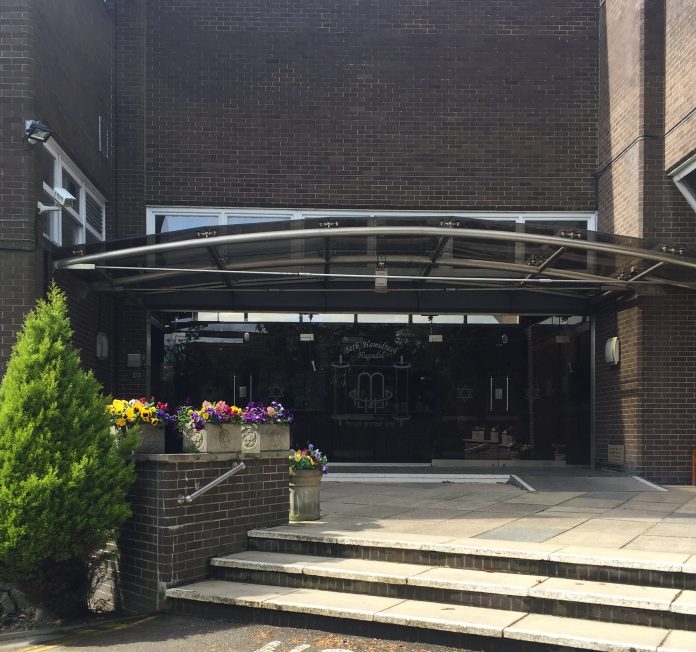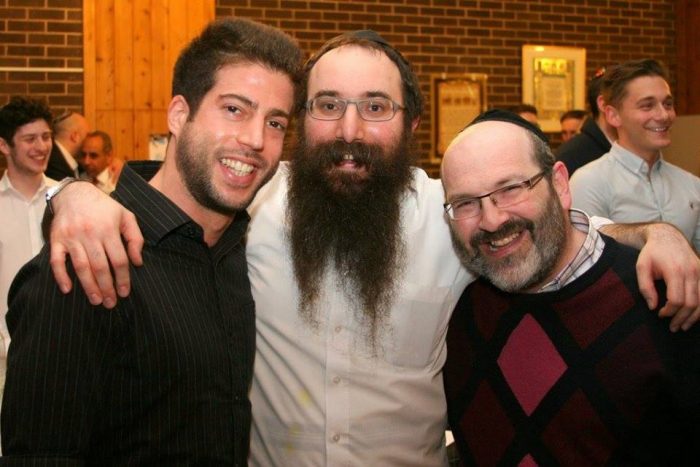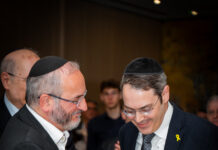
By David Saffer
A wave of optimism has swept through the Jewish community of Leeds in recent years.
Collaboration between organisations has seen record attendances for cultural, political and religious events.
Every week there is a hive of activity at the Marjorie and Arnold Ziff Community Centre. Youngsters have flocked to The Zone youth centre since its relocation to The Henry Cohen Campus, which also incorporates Brodetsky Jewish Primary School and Nursery, Leeds Jewish Free School, and Leeds Maccabi Football Club together with scout and guide movements.
Makor Jewish cultural office is awash with educational and community events, and the recent MILIM literary festival proved a smash hit.
Leeds Jewish Representative Council works in the background to benefit residents, whilst welfare and housing bodies do what they have always done, serve the needy. And when it comes to religion, a renaissance has taken place.
Leeds Talmud Torah has enjoyed partnerships with The Zone, LJFS and local Kollel.
Under the ‘Zone Ed’ banner, flexibility has been the watchword with Sunday classes taking place primarily for girls; midweek classes mainly for boys who represent Leeds Maccabi; a higher Jewish studies track for LJFS pupils who might have travelled down the M62 to Manchester for courses; whilst Kollel members teach school staff.
And a bat chayil programme has enjoyed a new era with 19 girls enrolled this year.
Doom mongers forecasting the demise of Leeds Jewry have, it seems, been silenced for good.
Change, sometimes radical, is not easy, especially for a synagogue steeped in longstanding traditions. But change is a necessity in the ever-developing landscape of Orthodox communities.
Beth Hamidrash Hagadol Synagogue comes into this category.
Not all decisions have been popular in recent times. But for senior minister Rabbi Jason Kleiman, who hails from Leeds, structured change has been required to take the shul forward.
BHH, as it is affectionately known, was founded in the old Jewish quarter of Leeds, where immigrants from Eastern Europe resided in Templar Street in 1874. Prayers were recited for a few years in a room rented in St. Alban’s Street until 1886, then on first floor of an old-fashioned building in Upper Hope Street over a butcher’s shop and bakery.
Rabbi Israel Zvi Levinson was the shul’s first appointed minister. The shul moved to a new, purpose-built site in Newton Road, Chapeltown, in 1937.
Based for nearly five decades in Street Lane, Moortown, the shul boasts around 1,000 families and was consecrated in March 1969 by then Chief Rabbi Dr. Immanuel Jakobovitz.
As a teenager, Rabbi Kleiman led services at the Queenshill Day Centre, Chassidishe, Harrogate and Bradford synagogues. He was then assistant chazan at Shadwell Lane Synagogue while studying theology and religious studies at the University of Leeds.
After graduating and marrying Elise in 1992 – the couple has three sons – he took up a position at Childwell Synagogue in Liverpool whilst teaching at King David High School.
The coming years would bring part time posts in Reading and Catford before completion of his semichah in 1997.
Five years’ service followed at Clayhall Synagogue prior to a return to his BHH roots.
Rabbi Kleiman was well aware of its exalted history, as it was his family shul.
A choir member under Rev Michael Saville, he returned full of ideas in 2005.
“It didn’t take long to settle as I was a Leeds boy, but the shul has changed dramatically,” he explained. “The main thing was to work out the pace of change.”
Part of a steering group that set up Tribe, then under the auspices of the United Synagogue, Rabbi Kleiman saw an opportunity.
“We took on the initiative in setting up LJOY (Leeds Jewish Orthodox Youth) based on what Tribe was doing on behalf of the Orthodox communities,” he recalled.
“Initially we were line managers, but now there is a committee – although it’s taken 10 years to appoint a full-time couple, Edwin and Suzy Chomer.
“We partnered with Mizrachi UK, which proved essential to its success, and broadened our remit, so in addition to high schools, we cover primary and upper years to have a continuum.”
When the shul’s Friday night minyan relocated to Brodetsky Primary School in the heart of the Jewish community of Alwoodley a few years ago, it split opinion among congregants.
“The minyan was getting less and less attended, so for core members who kept Shabbat it was a two-mile schlep and needed addressing,” Rabbi Kleiman, 47, recalled.
“We relocated but did not close our minyan down as some members perceived. Nobody living in Moortown was left high and dry; they could still attend a local service.
“We partnered with Bnei Akiva, which resulted in a more vibrant service; young people began to attend and led prayers. The Kabbalat Shabbat minyan was reborn. Numbers increased, regulars returned as it was local, and we’ve attracted non-members.”
Rabbi Kleiman added: “Some decisions are emotive and very difficult, but what once appeared radical is now deemed normal.
“The shul layout meant some people recited Kaddish behind a pillar, where you were not guaranteed a responsive minyan. When I suggested reciting it centrally in front of the bimah, some people felt it was too radical. But it’s now the norm and everyone in shul can hear.”
Rabbi Kleiman shares duties with Rabbi Mendel Sufrin, who previously had served the United Hebrew Congregation and was a product of the Lubavitch Kollel when it was in Leeds.
“Rabbi Sufrin’s role was initially pastoral so I was freed up to do outreach and educational work, but we now are very much a team.
“Traditionally, we employed a chazan and second baal koreh to lein; now we both cover these areas. Some members again were unhappy with the changes but they were necessary. Rabbi Sufrin and I regularly step into each other’s shoes when needed.”
Of the various debated issues in recent years, a potential move or merger of shuls due to the locality of Beth Hamidrash has been an ongoing discussion amongst congregants.
“A shul should be where people are and that is a challenge for us,” Rabbi Kleiman said. “Core members come regardless, but most do not live nearby and people are getting older.
“When you look at our needs, we naturally look at youth, but you must cater for everyone.
“We now hold a monthly Shabbat service at Brodetsky and it’s proved popular, especially with ladies. It’s a live issue in terms of where they sit in the main shul as there are steep steps upstairs, so we’ve experimented in bringing ladies downstairs. Some members like what we’ve done, others don’t, but we are not afraid to evaluate this important concern.
“When you walk into our shul it’s impressive, and there are people wedded to this building, so the thought of leaving does not sit well with them, but that was the case with Newton Road, The Vilna and Chapletown shuls before they all relocated.
“You cannot be complacent and do things as they were done 30 or 40 years ago.
“People want different things from a physical building, and the majority of people would not build a shul like we have today. This is something we must recognise.
“Modern shuls are on one level and made in such a way where women are as near to what is going on as the men are. So we must address this issue.
“Location matters, and whilst we are non-judgmental on how people get to shul on a Shabbat morning, we promote Orthodox values and should be in the heart of our main conurbation. However, whether we do it on our own or with partners remains to be seen.”
Aside from shul services, Rabbi Kleiman has welcomed an expansive educational and social programme.
“People engage on different levels, be it cultural, political or religious,” he explained. “We recently hosted a live Skype interview with an Israeli analyst that attracted new people, so we were on to something. Technology has made the world smaller.
“We are continually trying to find people with a particular expertise who can engage in shul activities. Members must feel valued beyond the traditional areas of davening, being a warden or organising a Kiddush. It might be a specific project such as Shabbat UK. It’s a question of broadening out to draw people in.”
Rabbi Kleiman acknowledges that BHH has made giant strides, but a question of ‘critical mass’ dictates the viability of services and activities.
“Some members want to daven in a smaller space, some want a straight-through ‘no frills’ minyan, whilst others want a Shabbat discussion event,” he explained.
“Years ago there was a main service on a Shabbat and festivals with various childrens services. At one time there was just one Megillah reading at Purim until we initiated an interactive family reading and this year collaborated with Orthodox shuls, so each was vibrant.
“There have been changes in explanatory services and guest speaker events have taken place, but you need a critical mass who wish to attend, because if you get a mass exodus in the main shul, the atmosphere is not the same.
“We constantly look at meeting different needs on a Shabbat so nobody feels left out. Modern-day shuls must offer choices. After all, why should someone come to a traditional service if it does not speak to them on a spiritual level.
“Whilst finding alternative ways of attracting people, we must maintain the integrity of Shabbat and other services. It is a constant challenge but one we must meet.”
Rabbi Kleiman added: “Change is not easy, it takes time and you have to be patient.
“People are sometimes fixated with the number of people in our community. It was bigger in past generations, but we are vibrant and there is more communally going on now than ever.
“The Jewish community of Leeds continues to surprise me, continues to stimulate me; and I am excited about the future chapters of this shul.”










